|
June 8–10, 2004 [Download PDF Version of Report] TABLE OF CONTENTS
OVERVIEW During the week of June 8, 2004, the Federal Motor Carrier Safety Administration (FMCSA), in conjunction with the Commercial Vehicle Safety Alliance's Roadcheck 2004, placed additional emphasis on the safety of hazardous materials being transported in cargo tanks. This special emphasis project was designated TANK CHECK 2004. Annette M. Sandberg, FMCSA Administrator, along with other government, law enforcement and industry officials participated at the kickoff event for Roadcheck which was coordinated by the Arkansas Highway Police and held at the state-of-the-art inspection facility located on I-40 in West Memphis, Arkansas. FMCSA's goal in placing special emphasis on cargo tank inspections is to improve the safety of the hazardous materials (HM) transportation system by focusing on HM carriers that transport HM in cargo tanks. There were a total of 3,7891 cargo tank inspections performed during Tank Check 2004 versus 2,907 inspections in 2003, an increase of 30 percent. This effort increases the level of safety awareness by HM carriers which results in increased compliance with the regulations and a corresponding reduction in the risk of HM incidents (spills). A secondary goal of the project focused on educating motor carriers and commercial drivers on the importance of using safety belts to reduce the risks of injury and death associated with a crash. This was accomplished by distributing safety belt brochures to drivers at inspection facilities and other strategic locations. Additionally, FMCSA Division Offices performed outreach activities to groups with an interest in improving highway safety and emphasized the Agency's Commercial Motor Vehicle Safety Belt Partnership Program with the American Trucking Associations (ATA), Motor Freight Carriers Association (MFCA), National Private Truck Council (NPTC), Commercial Vehicle Safety Alliance (CVSA) and Owner-Operator Independent Drivers Association (OOIDA). Studies have demonstrated that Class 3, flammable and combustible liquids, crashes and incidents account for about 56 percent of all HM incidents in a given year. Inspection results from this year's event indicate that of the 751 HM violations discovered, 364 of these violations were discovered on cargo tanks that primarily transport Class 3 materials (MC 3062 and DOT 4063 cargo tanks). Additionally, there were 716 MC 306 (20 percent of the total) cargo tanks inspected versus 587 DOT 406 (16 percent of the total) cargo tanks inspected but MC 306 cargo tanks accounted for 244 HM violations (32 percent of the total) discovered versus the DOT 406 tanks which accounted for 120 HM violations (16 percent of the total) discovered. This trend supports what we already know that older tanks require increased maintenance to prevent HM violations. The data collected from Tank Check 2004 assists FMCSA in its efforts to measure the level of compliance of motor carriers transporting hazardous materials in cargo tanks and other bulk packages. It also identifies opportunities to develop training material for the industry and target enforcement efforts in specific areas where improvement is needed. Tank Check 2004 involved performing primarily Level I4 and Level II vehicle inspections of cargo tanks at fixed roadside inspection facilities, mobile inspection facilities and intermodal facilities. The data for this project was obtained using the ASPEN inspection software and uploading this data to the Motor Carrier Management Information System (MCMIS) for analysis. The information in this report relied on the inspection data uploaded in MCMIS to generate the tank inspection results. Utilizing this procedure reduces the reporting activities for the Division Offices and reduces the need for Division Office/Service Center coordination. The reports generated from this data are contained under the heading Cargo Tank Inspection Data. A total of 49 Division Offices and 50 State inspection agencies participated5 in this activity. The Federal and State participants made Tank Check 2004 a very successful operation resulting in 3,611 cargo tank inspections with 4,501 violations discovered resulting in 732 Cargo Tank Motor Vehicles (CTMV's) being placed out of service (OOS). Although better than the national average for all commercial motor vehicles (CMV), a 16 percent OOS rate indicates there is an opportunity for improvement on the part of HM Carriers operating cargo tanks. Footnotes:
1 This number includes 178 cargo tank inspections performed by the State of California. These inspections do not reflect the type of tank therefore these inspections are excluded from the rest of the report.
2 This cargo tank specification is no longer authorized for construction after August 31, 1995.
3 This cargo tank specification is currently authorized for construction and is used primarily for the transportation of gasoline and other Class 3 materials.
4 North American Standard Level I Inspection - The most thorough driver/vehicle roadside inspection—a 37-step procedure that includes an examination of both the driver and vehicle. The driver inspection includes items such as the license and endorsements, hours of service, possible use of alcohol and drugs, and seat belts. The vehicle inspection includes items such as the brake system, coupling devices, exhaust system, frame, fuel system, lights, safe loading, steering mechanism, suspension, tires, van and open-top trailer bodies, wheels and rims, windshield wipers, and emergency exits on buses.
5 Determination of participation for Divisions and State agencies is based on the upload of the vehicle inspection data to MCMIS.
|
INVESTIGATIVE SUMMARY The following is a brief summary of Tank Check 2004 results. Additional information is contained in the Cargo Tank Inspection Data. - 3,611 cargo tank inspections were performed versus 2,907 in 2003, an increase of 24 percent from 2003.
- Of the 3,611 cargo tank inspections conducted, 80 percent (2,911) were conducted by State entities, while the remaining 20 percent (700) were conducted by Federal officials. This represents an 18 percent increase for State and 58 percent increase for Federal inspections over 2003 levels.
- Of the 3,611 cargo tank inspections conducted, 83 percent (2,989) were Level I inspections. This is a 16 percent increase in the number of Level I inspections over 2003 levels.
- Of the 3,611 cargo tank inspections conducted, 14 percent (512) had one OOS violation, 4 percent (138) had two OOS violations, 1.4 percent (51) had three OOS violations, and 0.86 percent (23) had four or more OOS violations.
- Of the 3,611 cargo tanks inspected:
- 36 percent (1,301) had no violations; this is consistent with last year's number of 37.8 percent.
- 22 percent (818) had one violation; this is consistent with last year's number of 22 percent.
- Of the 3,611 cargo tanks inspected:
- 46 percent (1278) were MC 306, MC 307 or MC 312 and resulted in 53 percent (397) of the HM violations discovered.
- 32 percent (1149) were DOT 406, DOT 407 or DOT 412 and resulted in 30 percent (224) of the violations discovered.
- Of the 3,611 cargo tanks inspected, there were 751 HM violations discovered and 364 of these HM violations were discovered on cargo tanks that primarily transport Class 3 materials. Of these violations discovered:
- 20 percent (716) of the total tanks inspected were MC 306 resulting in 32 percent (244) of the total HM violations discovered.
- 16 percent (587) of the total tanks inspected were DOT 406 resulting in 16 percent (120) of the total HM violations discovered.
- Of the 3,611 cargo tanks inspected, there were 751 violations of the Hazardous Materials Regulations and 29 vehicles were placed out of service because of identifiable releases of hazardous material.
CARGO TANK INSPECTION DATA Of the 3,611 cargo tank inspections conducted, 94.7 percent (3,419) were of vehicles of interstate motor carriers while 4.9 percent (178) were of intrastate non-HM motor carriers, and 0.4 percent (14) were of intrastate HM motor carriers.  Of the 3,611 cargo tank inspections conducted, 80.6 percent (2,911) were conducted by State entities, while the remaining 19.4 percent (700) were conducted by Federal officials. 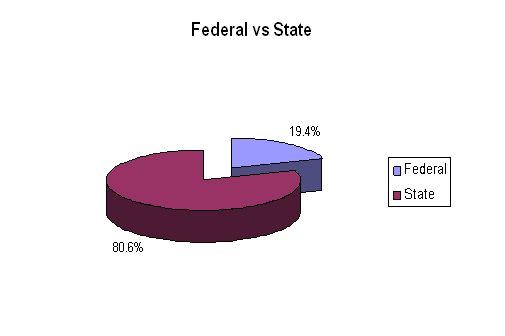 Of the 3,611 inspections, 82.77 percent (2,989) were Level I inspections, 14.76 percent (533) were Level II inspections, 1.14 percent (41) were Level III, 0.22 percent (8) were Level IV inspections and 1.11 percent (40) were Level V inspections.  Of the 3,611 cargo tank inspections, 19.83 percent (716) were MC 306's, 16.26 percent (587) were DOT 406's, 14.93 percent (539) were MC 307's, 13.51 percent (488) were exempt or non DOT specifications, 12.79 percent (462) were DOT 407's, 7.84 percent (283) were MC 331's, 5.37 percent (194) were unknown, 4.10 percent (148) were MC 312's, 2.77 percent (100) were DOT 412's, 0.91 percent (33) were MC 330's, 0.72 percent (26) were
MC 338's, 0.33 percent (12) were MC 304's, 0.22 percent (8) were MC 301's, 0.11 percent (4) were MC 310's, 0.11 percent (4) were MC 300's, 0.08 percent (3) were MC 311's, 0.08 percent (3) were MC 303's, and 0.03 percent (1) were MC 302's cargo tank motor vehicles inspected.  Of the 3,611 cargo tank motor vehicle inspections conducted, 36.03 percent (1,301) had no violations, 22.65 percent (818) had one violation, 15.62 percent (564) had two violations, 9.11percent (329) had three violations, 5.43 percent (196) had four violations, 4.15 percent (150) had five violations, 2.52 percent (91) had six violations, 1.80 percent (65) had seven violations, and 2.69 percent (97) had eight or more violations per inspection.  Of the 3,611 vehicle inspections, 80.87 percent (2,879) had no out of service (OOS) violations, 14.18 percent (512) had one OOS violation, 3.82 percent (138) had two OOS violations, 1.41 percent (51) had three OOS violations, and 0.86 percent (31) had four or more OOS violations.  Top Three Types of Violations Cited with One OOS Violation Of the 3,611 vehicle inspections, 18 percent (512) had one OOS violation. Top three types of violations were 396.3A1, 393.207(a), and 393.207(c). - 396.3(a) (1) Parts and accessories shall be in safe and proper operating condition at all times.
- 393.207(a) Axles, cracked, broke or loose from their mountings.
- 393.207(c) Leaf springs, cracked, broke or missing.
 Top Four Types of Violations Cited with Two OOS Violations Of the 3,611 vehicle inspections, 3.82 percent (138) had two OOS violations. Top four types of violations were 396.3A1, 393.207(a), 393.207(c), and 393.19. - 396.3(a) (1) Parts and accessories shall be in safe and proper operating condition at all times.
- 393.207(a) Axles, cracked, broke or loose from their mountings.
- 393.207(c) Leaf springs, cracked, broke or missing.
- 393.19 Turn signal systems.
 Top Three Types of Violations Cited with Three OOS Violations Of the 3,611 vehicle inspections, 1.41 percent (51) had three OOS violations. Top three types of violations were 396.3A1, 393.48(a), and 393.47. - 396.3(a) (1) Parts and accessories shall be in safe and proper operating condition at all times.
- 393.48(a) Brakes inoperative.
- 393.47 Inadequate brake linings.
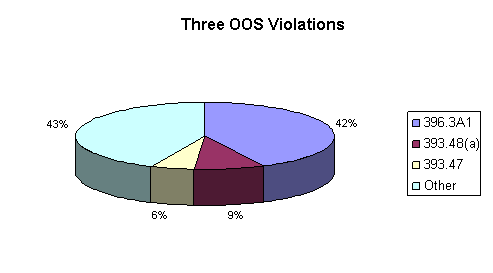 Top Six Types of Violations Cited with Four OOS Violations or More Of the 3,611 vehicle inspections, 0.86 percent (31) had four or more OOS violations. Top six types of violations were 396.3A1, 393.47, 393.207(a), 395.3(a) (1), 177.817(a), and 395.3(a) (2). - 396.3(a) (1) Parts and accessories shall be in safe and proper operating condition at all times.
- 393.47 Inadequate brake linings.
- 393.207(a) Axles, cracked, broke or loose from their mountings.
- 395.3(a) (1) Driving more than 11 cumulative hours after 10 hours off duty.
- 177.817(a) Improperly prepared and/or no shipping paper for the hazardous material transported.
- 395.3(a) (2) Driving after being on duty more than 14 hours.
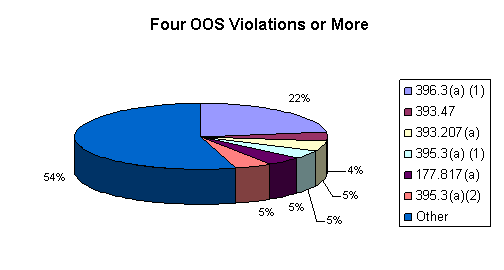 Of the 3,611 inspections conducted, there were 751 violations cited directly related to HM. Of the violations cited, 31.0 percent (233) were other HM violations, 23.4 percent (176) were for marking/placarding, 19.2 percent (144) were for shipping paper entries, 8.0 percent (60) were for emergency response information, 4.5 percent (34) were for no remote shutoff, 4.4 percent (33) were for no retesting and inspection for cargo tank, 3.9 percent (29) were for leaking, 3.5 percent (26) were for accepting shipment improperly marked, 1.2 percent (9) were for improper blocking and bracing, and 0.9 percent (7) were for using of non-specific container.  Inspections Conducted by State (Federal and State Combined) 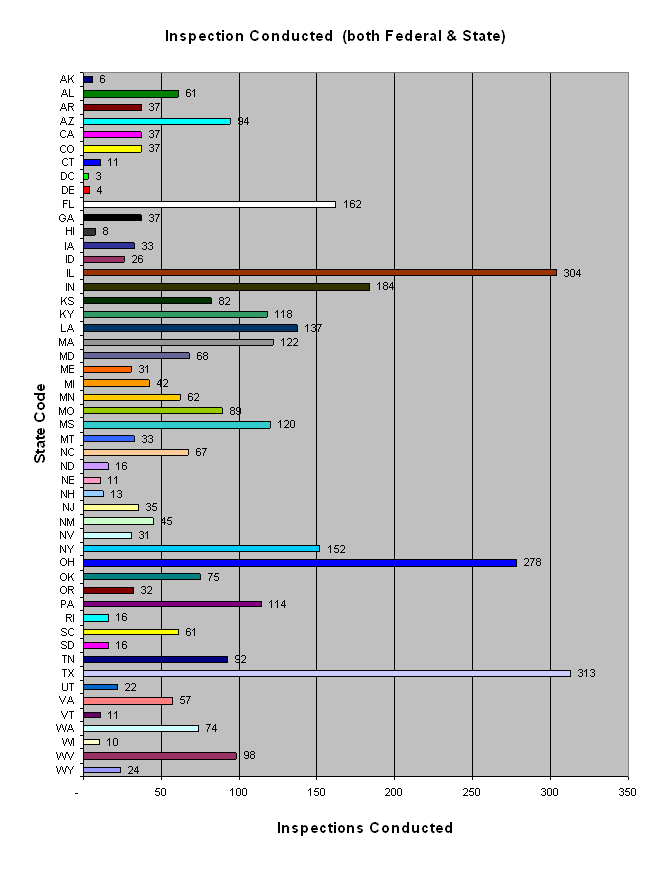 Federal Versus State Conducted Cargo Tank Inspections  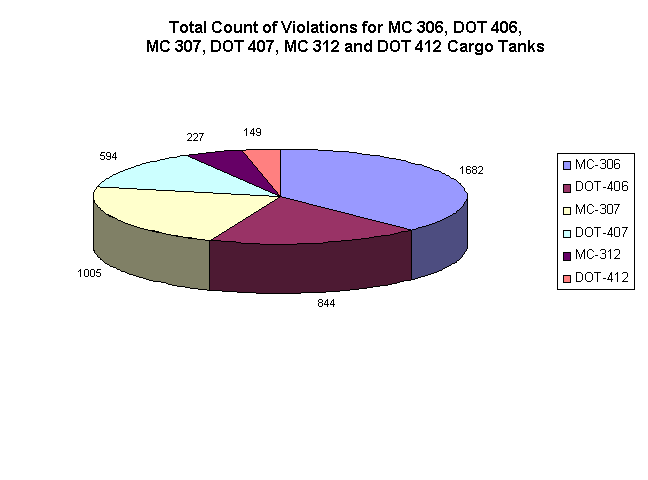 Comparison of MC 306 versus DOT 406 There were 1,682 violations discovered on MC 306 cargo tanks versus 844 violations discovered on DOT 406 cargo tanks for a total of 2,526 violations discovered on cargo tanks that primarily transport petroleum distillate fuels. Top Two (2) Violations for MC 306 Cargo Tanks The top two violations cited for MC 306 cargo tanks were brakes, all others (255) and brakes/out of adjustment (248). HM Violations for MC 306 Cargo Tanks There was a total of 244 HM Violations discovered for MC 306 Cargo Tanks. They are as follows: All other HM Violations 78; Improper placarding 49; Shipping Papers 34; No retest and inspection 33; No remote shutoff control 23; Emergency response 12; Leaking 9; Use of non-specification container were 4; Accepting shipment improperly marked 1; and Improper blocking and bracing 1.   Top Two (2) Violations for DOT 406 Cargo Tanks The top two violations cited for DOT 406 cargo tanks were brakes/all others (152) and lights (127). HM Violations for DOT 406 Cargo Tanks There was a total of 120 HM Violations discovered for DOT 406 Cargo Tanks. They are as follows: All other HM Violations 38; Improper placarding 24; Shipping Papers 20; Emergency response 15; No retest and inspection 13; No remote shutoff control 5; Accepting shipment improperly marked 3; and leaking 2. 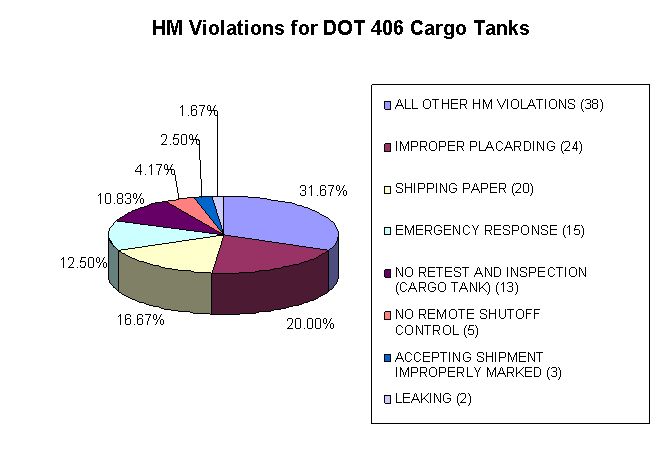  Comparison of MC 307 versus DOT 407 There were 1,005 violations discovered on MC 307 cargo tanks versus 594 violations discovered on DOT 407 cargo tanks for a total of 1,599 violations discovered on cargo tanks that primarily transport industrial chemicals and other corrosive materials. Top Two (2) Violations for MC307 Cargo Tanks The top two violations cited for MC 307 cargo tanks were brakes/all others (196) and brakes, out of adjustment (155). HM Violations for MC 307 Cargo Tanks There was a total of 121 HM Violations discovered for MC 307 Cargo Tanks. They are as follows: All other HM Violations 50; Improper placarding 14; Shipping Papers 14; No retest and inspection 27; Leaking 4; No remote shutoff control 2; Emergency response 6; Use of non-specification container were 2; Accepting shipment improperly marked 1; and Improper blocking and bracing 1.  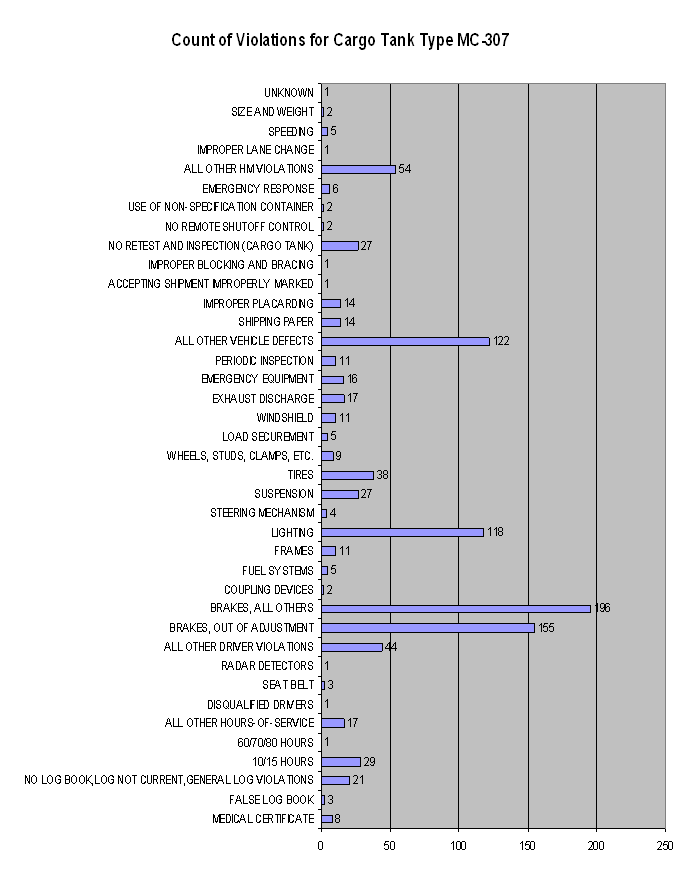 Top Two (2) Violations for DOT 407 Cargo Tanks The top two violations cited for DOT 407 were brakes/all others (102) and lights (82). HM Violations for DOT 407 Cargo Tanks There was a total of 81 HM Violations discovered for DOT 407 Cargo Tanks. They are as follows: All other HM Violations 33; Improper placarding 12; Shipping Papers 17; No retest and inspection 9; Leaking 7; Emergency response 2; and accepting shipment improperly marked 1.  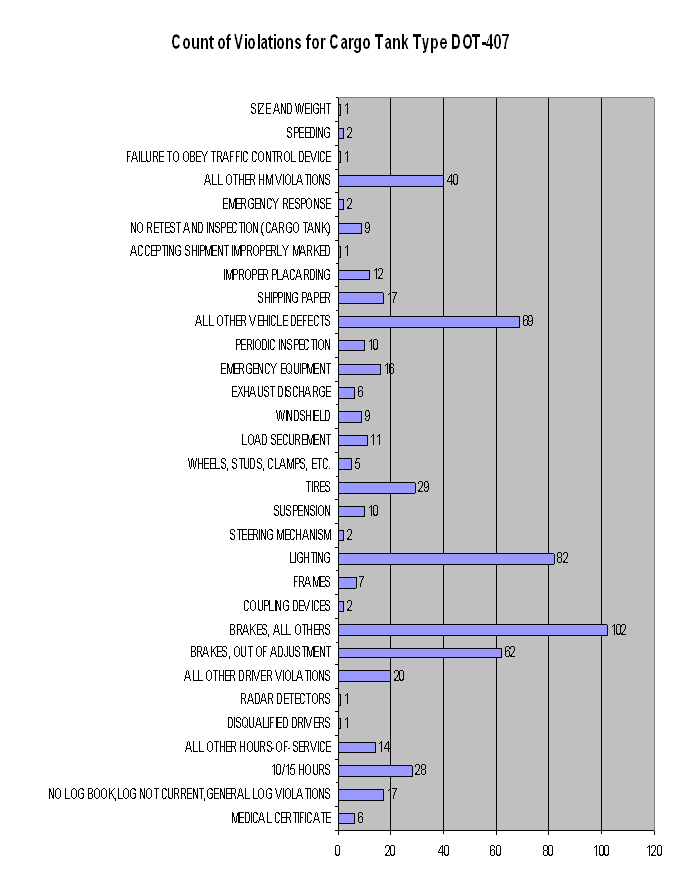 Comparison of MC 312 versus DOT 412 There were 227 violations discovered on MC 312 cargo tanks versus 149 violations discovered on DOT 412 cargo tanks for a total of 376 violations discovered on cargo tanks that are used in the hazardous waste industry, oil field and other industry where a tank designed to transport high density hazardous materials are required. Top Two (2) Violations for MC 312 Cargo Tanks The top two violations cited for MC 312 cargo tanks were brakes/all others (43) and brakes/out of adjustment (34). HM Violations for MC 312 Cargo Tanks There was a total of 32 HM Violations discovered for MC 312 Cargo Tanks. They are as follows: All other HM Violations 15; Improper placarding 3; Shipping Papers 5; No retest and inspection 4; Emergency response 1; Accepting shipment improperly marked 2; Improper blocking and bracing 1 and 1 leaking. 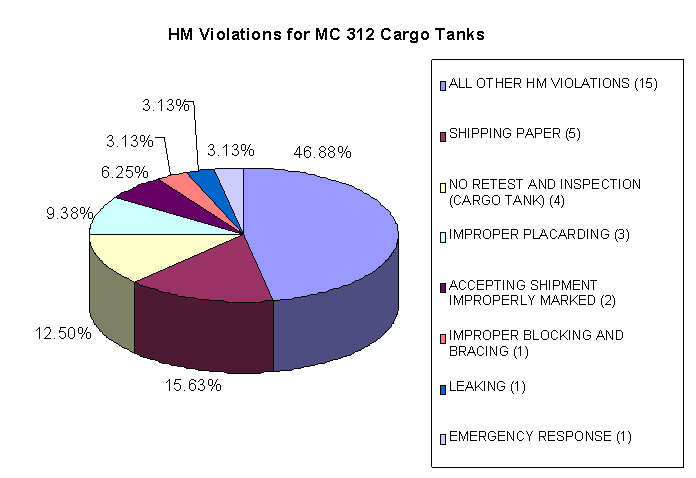  Top Two (2) Violations for DOT 412 Cargo Tanks The top two violations cited for DOT 412 cargo tanks were lights (27) and brakes/all others (27). HM Violations for DOT 412 Cargo Tanks There was a total of 23 HM Violations discovered for DOT 412 Cargo Tanks. They are as follows: All other HM Violations 7; Improper placarding 1; Shipping Papers 5; No retest and inspection 7; Emergency response 1; Improper blocking and bracing 1 and 1 leaking.  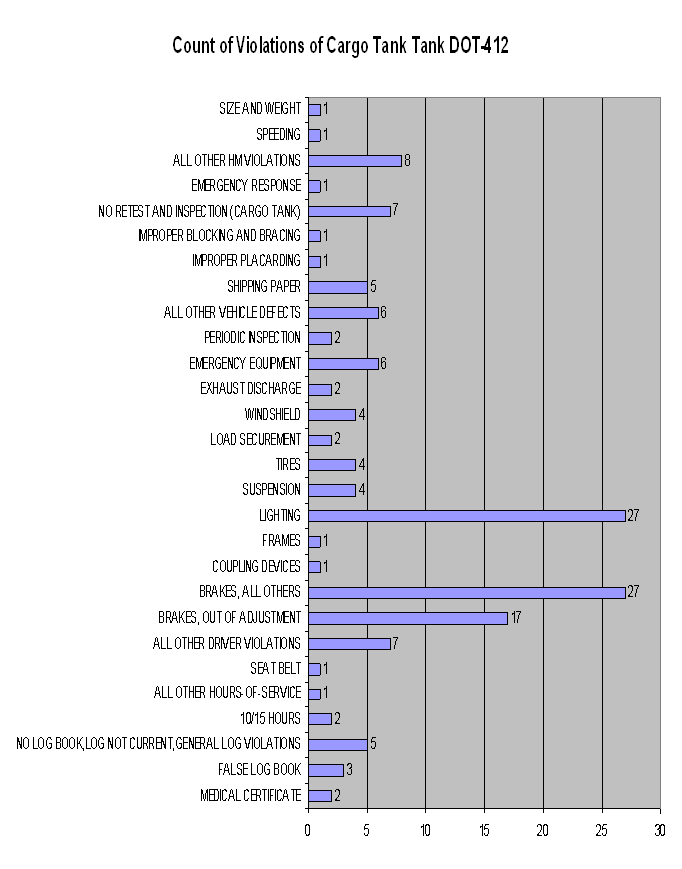
CONCLUSIONS Tank Check 2004 focused additional attention on HM carriers operating cargo tanks with the goal of reducing hazardous materials incidents. The results of Tank Check 2004 provide information highlighting the on-road performance of motor carriers operating cargo tanks and cargo tank motor vehicles. The data can also be used to measure the effectiveness of various enforcement programs of FMCSA and identify areas where improvement is needed. The violations discovered from the Tank Check 2004 project are consistent with the violations discovered from previous tank checks with respect to the percentage of violations discovered with one notable exception: There is a dramatic increase in both the number of 400-series tanks inspected and the number of violations discovered for these tanks and the disparity between the percentage of violations discovered for 300-series tanks versus the number of violations for 400-series tanks is shrinking. Some of the conclusions that can be made from this activity are: - The out-of-service rate for cargo tanks for 2004 continues to improve from previous years and is consistently below the national average year to year. This would indicate that efforts to improve hazardous materials safety are having a positive impact.
- There were 1,403 MC 306, MC 307 and MC 312 inspections making up 39 percent of all cargo tanks inspected versus 40 percent in 2003. This would indicate that the number of 300-series tanks still operating in 2004 is consistent with the numbers in 2003.
- Texas, with 296 cargo tank inspections, and Ohio, with 265 cargo tank inspections, were the top two States performing state inspections while Kentucky with 70 and Illinois with 53 were the top two Divisions performing Federal inspections. Overall, all Divisions had an increase in the number of inspections with the exception of Nevada. The Nevada Division did not report any inspection activity.
- Cargo tanks transporting Class 3 materials make up the largest percentage of tanks inspected. Violations discovered on MC 306 cargo tanks still make up a disproportionably large percentage of the HM violations discovered. This trend has been consistent since 1999.
- There was a 37 percent increase in the number of violations discovered for failing to retest a cargo tank over 2003.
- There was a 50 percent decrease in the number of violations discovered for using a non-specification container.
- There are still 1 percent of the cargo tanks that are discovered with an identifiable release of hazardous materials.
- DOT 407 cargo tanks made up 12 percent of the tanks inspected but made up 24 percent of the cargo tanks with an identifiable leak of hazardous material. MC 306 cargo tanks made up 20 percent of the tanks inspected and made up 31 percent of the tanks with an identifiable leak of hazardous material. This means that for every 10 leaking MC 306 cargo tanks, you will have 13 leaking DOT 407 cargo tanks if the same number of tanks were inspected.

|